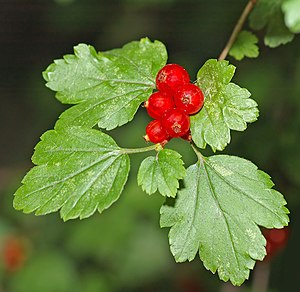Alpine currant
| Alpine currant | ||||||||||||
|---|---|---|---|---|---|---|---|---|---|---|---|---|

Alpine currant ( Ribes alpinum ) |
||||||||||||
| Systematics | ||||||||||||
|
||||||||||||
| Scientific name | ||||||||||||
| Ribes alpinum | ||||||||||||
| L. |
The alpine currant ( Ribes alpinum ), also called mountain currant , belongs to the gooseberry family (Grossulariaceae).
features
Vegetative characteristics

The alpine currant is a deciduous, densely branched shrub that reaches heights of up to 250 centimeters. In contrast to other Ribes species, the light gray branches have no spines or thorns. The bark can peel off in strips from older parts of the plant.
The stalked leaves are on short shoots in dense clusters. The leaf stalks are ciliate with long glandular hairs. The alternate leaves are triangular to rounded in outline, the leaf edge is roughly serrated. The leaf blades are 3 to 5 inches long and three to five lobed. The leaf blade is dull green on top, slightly shiny and glabrous on the underside.
Flowers and fruits
The alpine currant is dioeciously dioecious . The greenish-yellow flowers are mainly distributed in upright, inconspicuous bunches . The male inflorescences are 2 to 3 inches long and ten to 30 flowered. The female inflorescences are significantly shorter and five-flowered at most. The flower is always hermaphroditic in its disposition, due to the suppression of the stamen circles or the ovaries , but these are functionally unisexual. This species is therefore imperfectly dioecious.
The flower is four to five-fold and about 5 to 9 millimeters wide. The petals are significantly shorter than the sepals . Flowering time is from April to May. The flowers give off an incense-like fragrance.
The spherical berries are scarlet and taste rather bland. The fruit ripens from August.
Other features
The number of chromosomes is 2n = 16.
Occurrence
The alpine currant is widespread in Central and Northern Europe. It can also be found in the mountains of southwest and southern Europe and in northern and eastern Asia.
This species occurs from the plain to the subalpine altitude range . In Germany, it rises in the Alps at altitudes usually up to 1630 m. In the Allgäu Alps, it rises in the Tyrolean part on the Lachenkopf near the Jöchelspitze up to 1820 m above sea level.
In Austria the species is rare in the Central Alps, otherwise scattered. The alpine currant is missing in Burgenland and Vienna.
The lime-loving penumbra plant prefers noble deciduous forests, especially (block) ravine forests. Herb-rich mountain mixed forests of the montane and high-montane levels, mountain meadows, barberry bushes and also pine dry forests. It thrives in societies of the Tilio-Acerion, Fagion, Berberidion, Adenostylion and Erico-Pinion associations. The alpine currant occurs mainly on soils that are soaked in seepage, rich in nutrients and bases (mostly calcareous).
use
The alpine currant tolerates exhaust gases very well, which is why it is often used in different varieties (some with variegated leaves and small-stature) in the greenery of large cities and industrial areas.
literature
The article is mainly based on the following documents:
- Kremer, Strauchhöölze , Niedernhausen, 2002. ISBN 3-576-11478-5
Individual evidence
- ^ Manfred A. Fischer , Wolfgang Adler, Karl Oswald: Excursion flora for Austria, Liechtenstein and South Tyrol. 2nd, improved and enlarged edition. State of Upper Austria, Biology Center of the Upper Austrian State Museums, Linz 2005, ISBN 3-85474-140-5 .
- ↑ a b Erich Oberdorfer : Plant-sociological excursion flora . 8th edition, Ulmer, Stuttgart 2001, pages 495-496. ISBN 3-8001-3131-5
- ↑ Erhard Dörr, Wolfgang Lippert : Flora of the Allgäu and its surroundings. Volume 1, IHW, Eching 2001, ISBN 3-930167-50-6 , p. 663.
- ^ Kremer, Strauchhöölze , Niedernhausen, 2002. ISBN 3-576-11478-5
Web links
- Alpine currant. In: FloraWeb.de.
- Alpine currant . In: BiolFlor, the database of biological-ecological characteristics of the flora of Germany.
- Profile and distribution map for Bavaria . In: Botanical Information Hub of Bavaria .
- Ribes alpinum L. In: Info Flora , the national data and information center for Swiss flora . Retrieved November 4, 2015.
- Distribution in the northern hemisphere according to: Eric Hultén , Magnus Fries: Atlas of North European vascular plants 1986, ISBN 3-87429-263-0
- Thomas Meyer: Data sheet with identification key and photos at Flora-de: Flora von Deutschland (old name of the website: Flowers in Swabia )
